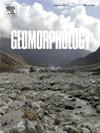Multi-scale analysis on the geomorphic evolution of Macao debris flow gully (NW China)
IF 3.1
2区 地球科学
Q2 GEOGRAPHY, PHYSICAL
引用次数: 0
Abstract
The multiscale geomorphic evolution of the Macao debris flow gully was analyzed by integrating field surveys and quantitative analysis of morphometric parameters derived from multi-temporal 2.5 m-resolution Digital Elevation Models (DEMs) (2014–2024). At the watershed scale, temporal trends in hypsometric integral and surface incision parameters indicate an early-maturation stage with a paradoxical shift toward rejuvenation, driven by sustained incision-erosion dynamics. Channel-scale analysis reveals a systematic rightward deflection of flow trajectories, resulting in an 11 % increase in steepness on the right slope versus the left over the decade, alongside pronounced asymmetry in slope development stages (the right slope being younger than the left). Cross-sectional profiles exhibit a U-shaped morphology dominated by lateral erosion, with erosion rates on the right-slope exceeding those on the left in multiple channel segments. The persistent rightward deflection of flow trajectories and the associated amplification of right-slope erosion are consistent with Coriolis-induced centrifugal force imbalances, suggesting that rotational effects play a role in controlling lateral erosion at channel bends. These findings establish a process-form feedback framework linking morphometrics to macroscale gully evolution, offering actionable insights for enhancing erosion prediction models and optimizing terrain-specific mitigation strategies in subtropical debris flow systems.

澳门泥石流沟地貌演化的多尺度分析
利用2014-2024年多时段2.5 m分辨率数字高程模型(dem)的地貌测量参数,结合野外调查和定量分析,对澳门泥石流沟的多尺度地貌演化进行了分析。在流域尺度上,剖面积分和地表切口参数的时间趋势表明,在持续的切口-侵蚀动力学的驱动下,流域处于早期成熟阶段,并矛盾地向年轻化转变。通道尺度的分析揭示了水流轨迹系统性的向右偏转,导致十年来右坡陡度比左坡陡度增加11%,同时边坡发展阶段明显不对称(右坡比左坡年轻)。剖面呈u型形态,以横向侵蚀为主,多沟道段右坡侵蚀速率大于左坡侵蚀速率。水流轨迹的持续向右偏转和与之相关的右坡侵蚀的扩大与科里奥利引起的离心力不平衡一致,这表明旋转效应在控制河道弯道的侧向侵蚀方面发挥了作用。这些发现建立了一个过程形式的反馈框架,将形态计量学与宏观尺度的沟壑演变联系起来,为增强亚热带泥石流系统的侵蚀预测模型和优化地形特定的缓解策略提供了可行的见解。
本文章由计算机程序翻译,如有差异,请以英文原文为准。
求助全文
约1分钟内获得全文
求助全文
来源期刊

Geomorphology
地学-地球科学综合
CiteScore
8.00
自引率
10.30%
发文量
309
审稿时长
3.4 months
期刊介绍:
Our journal''s scope includes geomorphic themes of: tectonics and regional structure; glacial processes and landforms; fluvial sequences, Quaternary environmental change and dating; fluvial processes and landforms; mass movement, slopes and periglacial processes; hillslopes and soil erosion; weathering, karst and soils; aeolian processes and landforms, coastal dunes and arid environments; coastal and marine processes, estuaries and lakes; modelling, theoretical and quantitative geomorphology; DEM, GIS and remote sensing methods and applications; hazards, applied and planetary geomorphology; and volcanics.
 求助内容:
求助内容: 应助结果提醒方式:
应助结果提醒方式:


